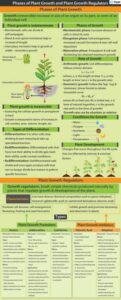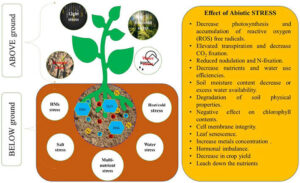Back to: Botany 400 Level
Hello, my amazing Afrilearn scholar! Welcome back to another exciting lesson in plant physiology. Today, we’re going to learn about synthetic plant growth regulators (PGRs), which are man-made chemicals that mimic the action of natural plant hormones. These synthetic hormones have been designed to help us control plant growth and development in various ways. By the end of this lesson, you’ll understand how these chemicals are used in agriculture, horticulture, and research to improve crop yields, control growth patterns, and even promote flowering and fruiting. Let’s get started!
Synthetic plant growth regulators and their applications
Have you ever wished plants could grow faster, flower earlier, or produce more fruit? Well, with the help of synthetic plant growth regulators, or PGRs, we can do just that! These chemicals are artificial versions of the hormones that naturally occur in plants, like auxins and gibberellins. Farmers, gardeners, and researchers use PGRs to manipulate plant growth in ways that help crops grow better and more efficiently. Think of them as tools in a gardener’s or farmer’s toolbox, designed to help plants grow under specific conditions or in particular ways.
What are Synthetic Plant Growth Regulators?
Synthetic plant growth regulators are chemicals created in laboratories to mimic the effects of natural plant hormones. They are used to regulate plant growth, flowering, fruit development, and other vital processes. These PGRs can either promote or inhibit certain plant functions, depending on the desired outcome.

There are many different types of PGRs, and they are often grouped according to the process they influence. Some of the most common synthetic PGRs include:
Auxin-like PGRs (e.g. IAA – Indole-3-acetic acid, NAA – Naphthaleneacetic acid)
Gibberellin-like PGRs (e.g. GA3 – Gibberellic acid)
Cytokinin-like PGRs (e.g. BAP – Benzylaminopurine)
Ethylene-like PGRs (e.g. ethephon)
Abscisic acid-like PGRs (e.g. ABA analogs)
These synthetic PGRs can be applied in various ways, such as through sprays, soil applications, or even by injecting them directly into the plant.
Applications of Synthetic Plant Growth Regulators
Promoting Root Development
One of the most common uses of synthetic auxins (like NAA) is to promote root development in plant cuttings. When you take a cutting from a plant and want it to grow roots, you can treat it with auxins to encourage root formation. This helps in plant propagation, especially for crops like tomatoes and sweet potatoes.
Example:
Think of auxins like a cheerleader encouraging new roots to grow. When a gardener wants more plants, they use auxins to help the cuttings root faster.
Controlling Plant Growth
Gibberellins are used to control the height of plants. For example, they can make crops like rice grow taller, or they can be used to dwarf plants (make them shorter) in certain situations. This is especially useful for crops that need to grow under controlled conditions, such as those in greenhouses.
Example:
Imagine gibberellins as the stretching potion for plants, helping them grow taller and stronger when needed. On the flip side, they can also be used as a growth-limiting tool when you don’t want a plant to grow too high.
Inducing Flowering and Fruit Setting
Cytokinins are often used to induce flowering in plants that require specific triggers to bloom. For example, in cucumbers, applying cytokinins can encourage the plant to flower earlier, leading to more fruits in a shorter period. They are also used in fruit setting in crops like tomatoes to ensure good fruit production.
Example:
Cytokinins act like the “alarm clock” that tells the plant, “It’s time to bloom!” When farmers want a burst of flowers, cytokinins are their go-to regulators.
Promoting Fruit Ripening
Ethylene-like PGRs, such as ethephon, are used to promote fruit ripening. For instance, in bananas, ethephon can be sprayed to induce the ripening process, ensuring the bananas ripen in a uniform manner, especially for commercial use.
Example:
Think of ethylene-like PGRs like the coach who says, “Alright, it’s time to get ready for harvest!” They trigger the ripening of fruits when they are at their peak.
Seed Dormancy and Germination
Abscisic acid-like PGRs are used to break seed dormancy and promote germination in crops. For instance, certain agricultural crops that have hard seed coats or dormant seeds can be treated with these PGRs to ensure the seeds start growing when conditions are right.
Example:
These PGRs act like a wake-up call for seeds that have been sleeping. When conditions aren’t right for germination, abscisic acid-like regulators tell the seed, “It’s time to grow!”

Advantages of Synthetic Plant Growth Regulators
Increased Crop Yield: By controlling flowering, fruiting, and growth, PGRs can help farmers produce more food from less land.
Efficient Growth Control: PGRs can help prevent overgrowth, ensuring plants grow in a controlled and desirable way.
Reduced Pest and Disease Pressure: By regulating plant growth, PGRs can make plants more resistant to pests and diseases.
Improved Quality of Produce: PGRs help produce uniform fruit ripening, ensuring that the fruits are of high quality for the market.
Summary
Synthetic plant growth regulators (PGRs) are artificial hormones used to control various plant processes.
They are commonly used for root development, growth control, flowering, fruit ripening, and seed germination.
Some examples of PGRs include auxin-like, gibberellin-like, cytokinin-like, ethylene-like, and abscisic acid-like chemicals.
These PGRs help farmers and gardeners improve crop yields, manage plant growth, and ensure high-quality produce.
Evaluation
- What is the role of synthetic auxins in plant propagation?
- How can gibberellins be used to control the growth of plants?
- Why are ethylene-like PGRs used in fruit ripening?
- What advantages do synthetic plant growth regulators offer to farmers and gardeners?
You’ve just learned about the incredible world of synthetic plant growth regulators and how they can help us manage and improve plant growth. These PGRs are like the secret ingredients that make plants thrive in ways we can control and optimise. You’re one step closer to becoming an expert in plant physiology! Keep up the fantastic work and get ready for the next lesson. You’ve got this! Keep growing and learning! 🌱
